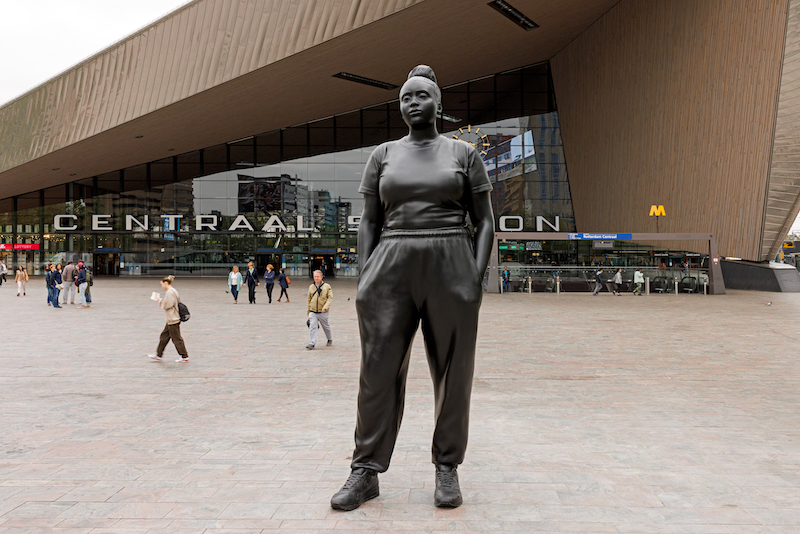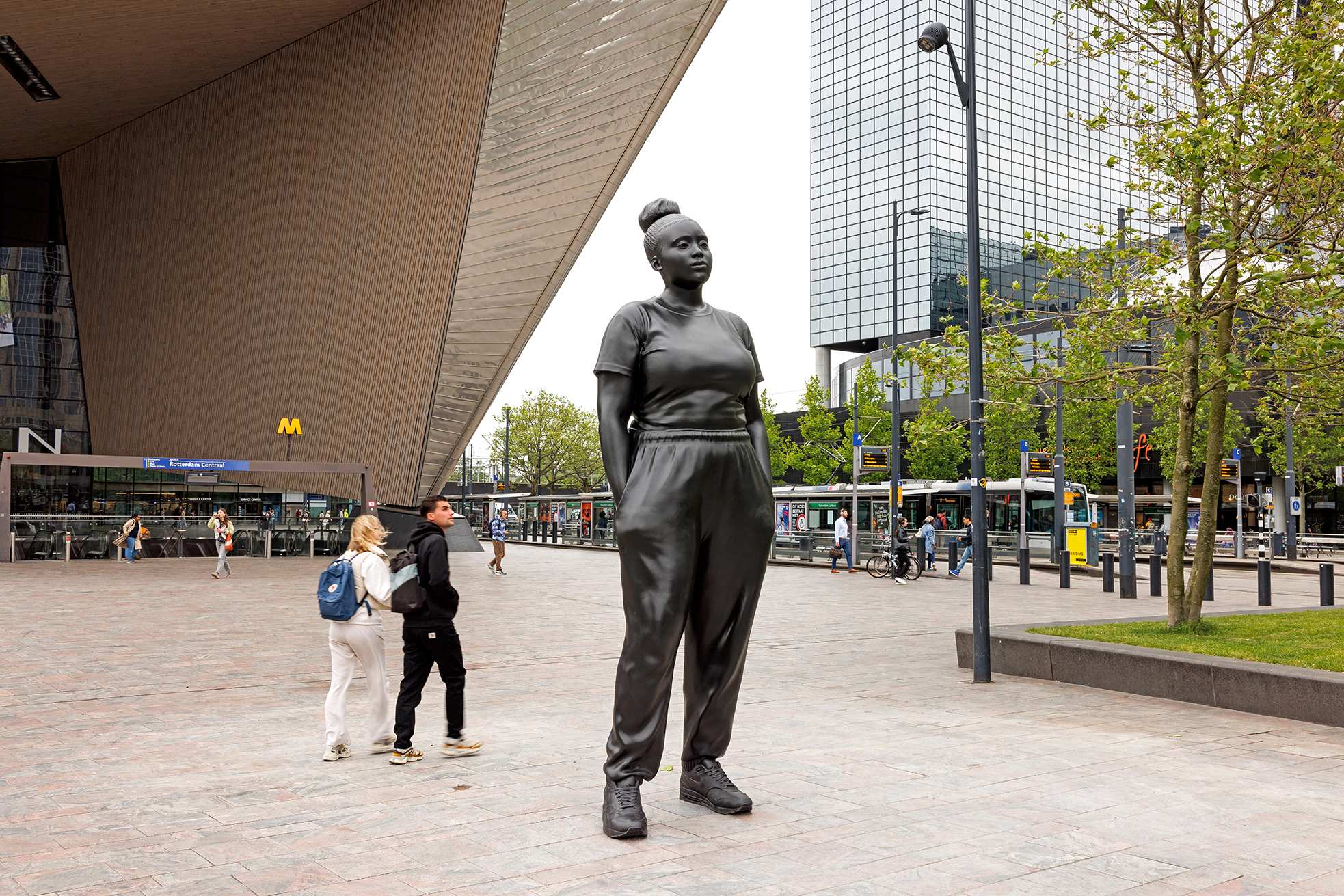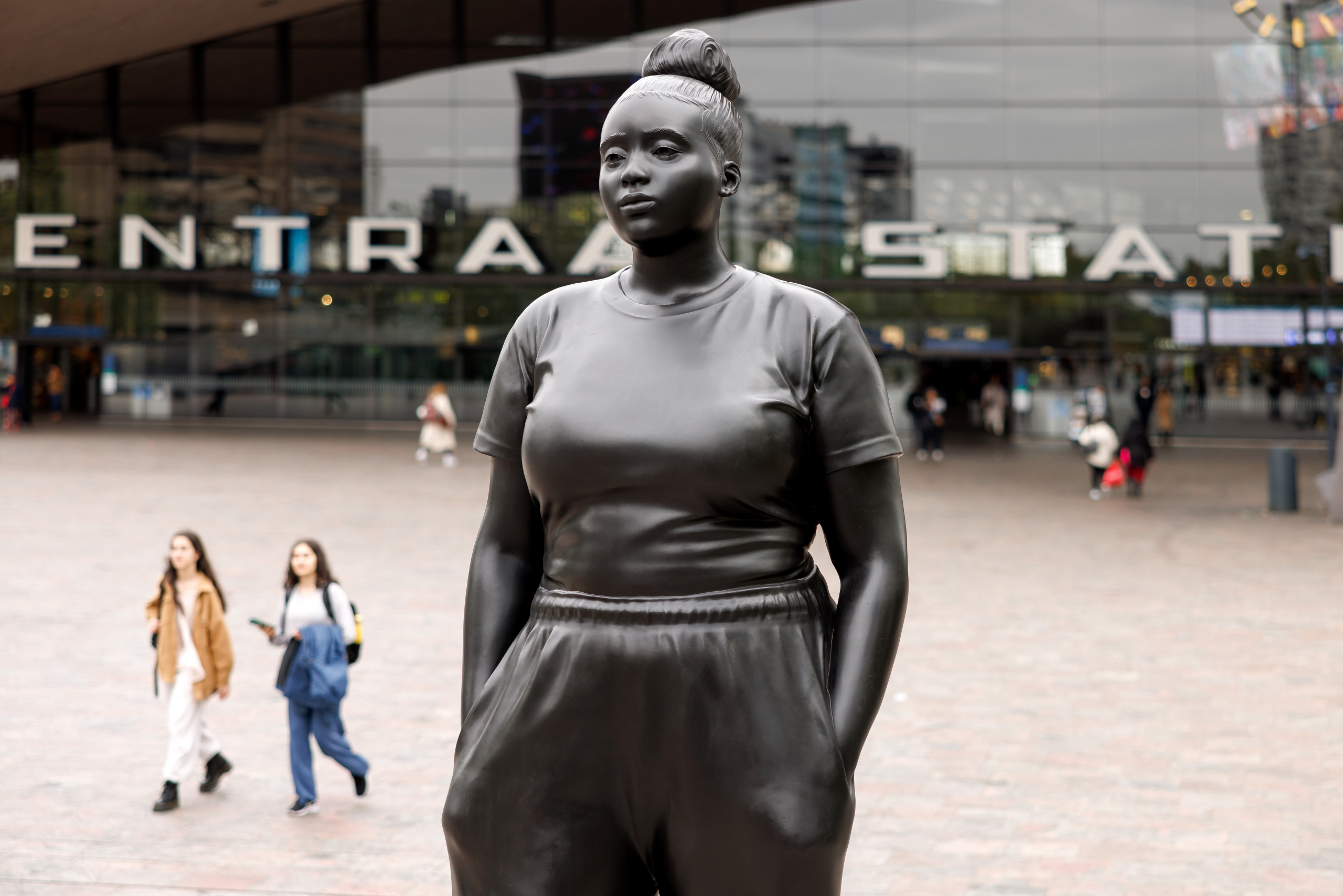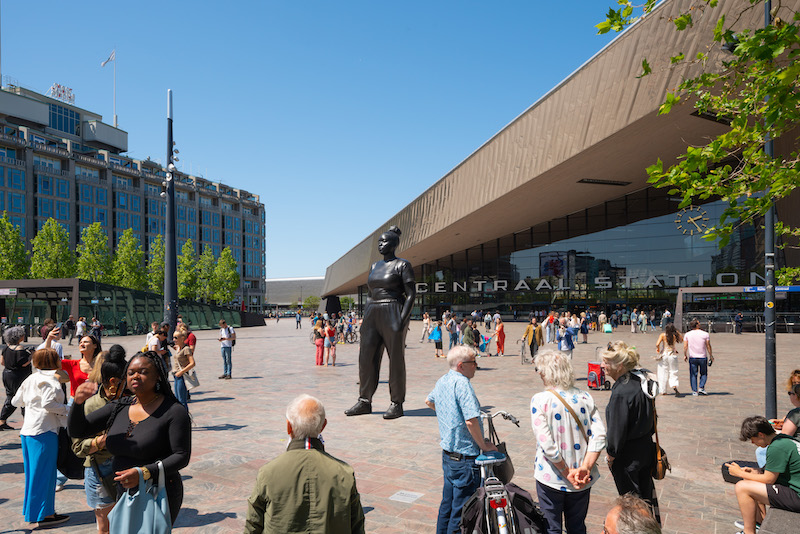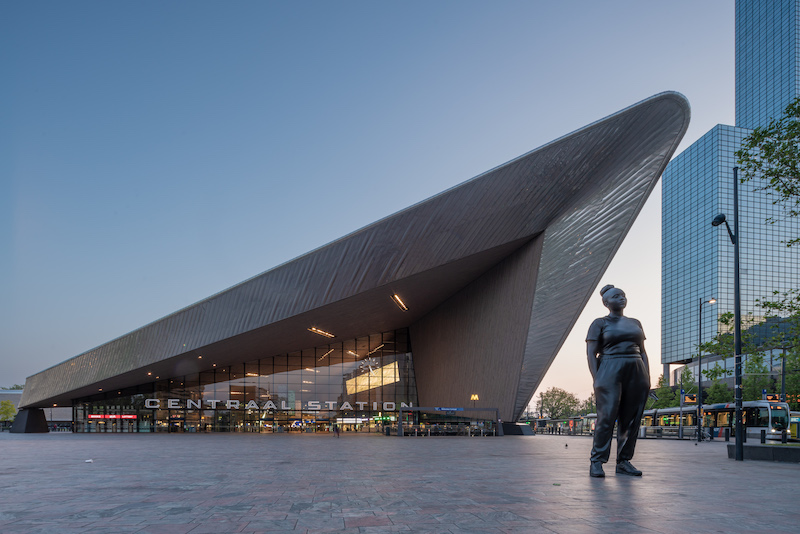Operatic stillness
By Simone Zeefuik
Notes on a loving, part 1. For Jeanine van Berkel, whose imagination and kindness inspire me.
It’s exactly because she’s not looking at anyone that I know we’re seen. Not watched but understood in our desires to see ourselves in the sceneries of the cities that we’re part of. She inspires me in these considerations that have been heavily on my mind: I’m in need of our visibility to not depend on our physical presence. And, I long for a visibility that’s centered around a recognition that actually brings us joy. Or at least a soothing, a relief that doesn’t require or remind us of a wrecking.
For this gentleness to happen in the form of a four metres tall ode to our moments of rest and our interior lives, that’s a loving. Moments Contained, the work of British sculptor Thomas J Price that will be installed on the square in front of Rotterdam’s Central Station, is a loving. There’s a softness to her. Part of it has to do with the intentional choices with regards to material and form, yes. But, there’s also her vibe of easing, a settling into self that’s both focused and flowing. The serenity with which she looks both beyond the viewer and inwards makes me think about Stillness. Hers, ours.
She’s part of my reconsidering and rethinking of Stillness as matters of space. And, how powerful it is to create these spaces in the midst of chaos. Or, as Toni Morrison taught us, as a response to it. Seeing Moments Contained, this beautiful praise to pause, in a space that’s so synonymous to sound, busyness and haste, is poetic. It’s a beauty we often miss or rush past because we have been made to believe that stillness is a waste of time rather than a part of it. Relearning to not just value our sounds and to also recognize ourselves when we’re not presented in a spectaclized forms, requires imagination.
Often, we need something to build our imagination on, so bless the hearts of artists who, when considering how to portray us, choose our Quiet. Decisions like this require vision and care. And, tenderness because even without her plinth, it takes more than craft and an eye for carefully laid baby hairs to make a four meter tall girl represent relatability. Especially if that relatability is a subtle, ever so clever method to not just critique, but to refuse these Eurocentric links between scale, materials, form and importance. With Moments Contained, Price offers us ourselves in one of my favourite forms of rest: unbotheredness.
Because of his intentional decision to offer us very few codes to contextualize her, she’s a nod to the perhaps. A speculation. We can’t even be sure of what it is she’s doing. At first consideration, I imagined her to unclench her fists. It reminded me of an Instagram post about loosening our shoulders, lowering them and not pressing your tongues to the roof of your mouths. I forgot the source but recall the lesson and every so often, when I find myself trying to exhale towards relaxation, I’m reminded of these instructions. Maybe we see her in the moment right after that realization and in the midst of easing. Then again, perhaps she just snapped her fingers.
Try it: right after the snap the hand curls into what looks like a fist. Maybe that’s what’s happening. Perhaps her thoughts drifted her along a sonic soothing. And maybe, as she thought about what the work of Romana Vrede and Adison dos Reis taught her about belonging she remembered the sounds of Benjamin Clementine and Césaria Évora. It could very well be that, as her mind’s ear smoothed his operatic voice towards her heart-movin’ Morna, she remembers Lorraine Hansberry’s note about a classical people deserving a classical art and as a co-sign she *snapped*.
The plethora of possibilities offered through Moments Contained shows us that with his sculpture, Thomas J Price offers us a work that is both art and artist. Whoever people imagine her to be and whatever they think she’s doing, says a lot about the person who’s watching at her. Those who are not concerned with the ways how folks who they find irrelevant are looking at them, become spotlights.” When you don’t engage with someone’s urge to turn you into a spectacle, you redirect that focus they tried to put on you right back unto their faces. The circus they tried to build now turns into a one-person clown show because why on Wangari Maathai’s earth are they getting so worked up about this?
For example: when you’re asked to smile but you don’t, there’s a disruption. When you’re asked to behave according to certain social codes that promise very specific forms of comfort and you don’t, something changes. When you think statues are about status, grandeur and value… and you believe that the honour of your awe must never be bestowed upon a young, Black woman wearing casual clothing and sneakers… yet she still appears, refusing to give you even a fraction of the attention that she put into those baby hairs… mad things rearrange.
These shifts, no matter how humble or massive, inform us. About others, about ourselves… More than carefully phrased intentions or whoever we hope we are, these changes tell us something about our abilities to connect to each other. They’re information. Which gives Moments Contained its double role of art and artist, sculpture and creator of psychological portraits based on people’s world views.
Our daily experiences are cluttered with distractions. Cookies, clickbait and other ways of grasping for attention, sure. But, I’m specifically talking about these distractions that, as Toni Morrison once analysed, keep us explaining our reasons for being. I’m curious to experience how the installation of Moments Contained will impact our senses of belonging. And, I wonder about hers. I look forward to seeing what the organisations involved in her placing her at the square in front of Rotterdam Centraal Station put together for her installation ritual. Her homecoming, if you will. I wonder what, to them, matches Stillness. Hers, ours.
My ceremony would include a sixtysomething, soprano singing, Cape Verdean aunt and Pelumi Adejumo. They would both be dressed in Marga Weimans’ reimaginations of Moments Contained’s outfit. I’d invite them to stand on a 2,5 metre high installation across from, but not too close to our new Rotterdammer. There, as we’d gather in between them, I’d let the three reimaginations of our Quiet cross their representation of our unbotheredness. That. Four metres above our heads and as close as we imagine that to be, that would be my welcome. A sonic settling of the possibilities we represent. A homecalling. A loving.
Unbothered, still
By Simone Zeefuik
Notes on a loving, part 2
In the most beautiful scenarios, speechlessness results in a reconsideration of the vocabularies we choose. Depending on the conversations we hope to have, it makes us think about a more intentional use of it. What do we want to say? What do we mean and who do we mean by it? And, if we mean ‘everyone’… who gets to symbolize that universality? Who may consider themselves relatable? Who needs to have a reason? Who is allowed to, without disclaimers and without having to have earned it, just be? Judging by the tears we shed at Rotterdam Centraal on Friday 2 June during the installment ceremony of Moments Contained, the beautiful sculpture by British artist Thomas J Price, there haven’t been enough times in which we were our own answers.
It didn’t matter that many of us already knew what the sculpture looks like and that her head had been sticking above the fences around her for a few days. We would still be surprised. After all, we still had no idea what she we would do, we didn’t know how she would activate us and the square in front of Rotterdam Centraal. Despite the fact that we didn’t exactly know the hows and whats, we already felt that, eventhough the gorgeous, bright blue fabric was only been draped over her, what would be revealed wouldn’t only be hers. There, beneath what appeared to be the satin equivalent of blauwsel, also awaited the emotions associated with recognition. By counting down to her reveal, we also brought ourselves to our new placing in this city, a highly anticipated marker on a map that’s still too blanc.
Sculptures and statues that are not just of but are also made by Black artists, make me think in maps. They make me wonder and imagine what the maps of places, provinces, countries, regions in Western Europe would look like if we drew them based on Black presence. What would such a mapping look like if this presence didn’t depend on the physical presence of the Black folks who live there? Which Dutch cities would initially be on this list? Which would be allowed to stay on it when the art works and street names related to slavery and African Americans are not included? For example, what remains of ideas about home, togetherness, ‘for everyone’ and the pride some people take in stating the number of nationalities that live in their city when the presence of these residents isn’t reflected in the city’s public art? What if we measured Black presence by its impact on the art works in these public spaces?
The installment of Moments Contained, which was donated to the city by Stichting Droom en Daad, makes Rotterdam an even greater platform for conversations about the future of art in the public spaces of Western Europe. The conversations sparked by Moments Contained aren’t just about Rotterdam or the Netherlands. They say something about the memory-cultures and imagination of countries whose status quo is having the utmost difficulties dealing with what Aimé Césaire calls the unsustainability of Europe. In addition, but certainly not least, it says something about the near future and different forms of visibility as imagined by our various Afro-European communities. What we display is often a reflection of what we think, think or at least hope underlines our value. Moments Contained is, for those who needed one as specific and beautiful as her, an invitation to rethink this. In the conversations we had that afternoon at Rotterdam Centraal, both with friends and unknown fellow witnesses of this beautiful moment, many of us mentioned that Moments Contained was ‘just’ standing and that she’s not necessarily concerned with other folks. ‘It’s so nice to see that we can also just chill, that we don’t always have to engage with whatever seeks our attention and demands something from us,’ a twenty-something person next to me pointed out.
The tears that lovingly flowed from Shanygne Wiebers’ speech and throughout the choreography created by Sheree Lenting and her team felt, in part, like we were releasing our exhaustion. To be yourself in a society in which the domination groups only recognize some parts of yourself, is absolutely tiring. It’s a constant, daily fatigue. To see yourself in the image of a young lady who is just minding her business, is a loving. My good sis Aïda Sium thought that our tears symbolized a blessing. “Like how you christen a ship before it sets sail. But, in this case, we do it to celebrate her arrival and to wish her protection.” I noticed how many of us were concerned about the sculpture. Some of us wondered if she was placed firmly enough and we were concerned about the ways in which some people might want to touch her. When it comes to Black girls, young ladies and women, something wild happens to other people’s feelings of ownership and access…
Aïda and I were discussing it some more when a lady came over and stood right behind us. Although one can never be certain when it comes to our elders, we guessed that she was somewhere in her 70s. We greeted her with the respect we have learned from our families and asked her if she wanted to pass us. She said that this wasn’t necessary: she preferred to look at Movements Contained from where we stood. After a few seconds she asked what such a work of art is called. “What do you suggest we call her, madame?” I asked her. “A statue, I think?” she doubted. I told her that this is something we could decide ourselves, that we could call her a statue if that’s how we see her. The lady asked if she represented a real person and she was pleasantly surprised when we told her about both the symbolism and the intentions of the work. Our new auntie took another look at the statue, stated that she had never seen anything like it before and proudly concluded: “Ay, she’s a statue!”
Aside from the material, size and whether or not a they have plints, statues are of course also about a Who. Who deserves to, in a very literal sense, be looked up to? Who is inspiring enough for these grand proportions? Who, without explanation and without having to deserve it, is allowed to be so grand? It was beautiful beyond words to, while enjoying Price’s work, think about this together on that Friday afternoon.
She’s so welcome and, despite her very recent arrival, so Rotterdam. And, of course, a Rotterdam pharaoh has her hands in her pockets. Of course our contemporary version of the Ancient sculptured we know is chilling in a casual-looking outfit. Real talk, who wants to be known for being in battle? All the Black folks I know crave softness and stillness.
It was heartwarming to see how many folks wanted their picture taken with her and Thomas J Price. Everyone gave it their something: the little ones came with their poses, the grownups brought their stories. Rotterdam’s mayor predicted that this would become the city’s most photographed work of art. Let’s think carefully about what this means and what it says about the need for representation, about the different levels of recognition. Let’s not just look at the number of photos, but let’s pay close attention to the faces, to the shining of the eyes and the joy in the poses. And, let that inform us about what kind of public spaces we want for ourselves.
On the way to the restaurant where my sisters and I often gather when we want to unpack events that are important to us, we cross paths with a familiar face and her daughter. The daughter, probably about nine years old, is wearing such a cool outfit. Her boxbraids are a mix of black, red and blue so I instantly trust her taste. We ask her if she enjoyed the dance performance and what she thinks about the sculpture. She smiles and tells us how beautiful she thinks Moments Contained is. I ask her if she thinks the sculpture looks like her. She nods, proudly, and I ask what she likes most about her. During the candy-sweet “Eeehhmm…” of her considerations, her glance travels from us, to the sky and via her mother to Moments Contained. She looks at us again and says, “Everything!” Everything. Looking at a sculpture in which she recognizes herself, our new niece decides that what she likes most about her is everything. Everything.
May we soon have more times in which we are our own answers
